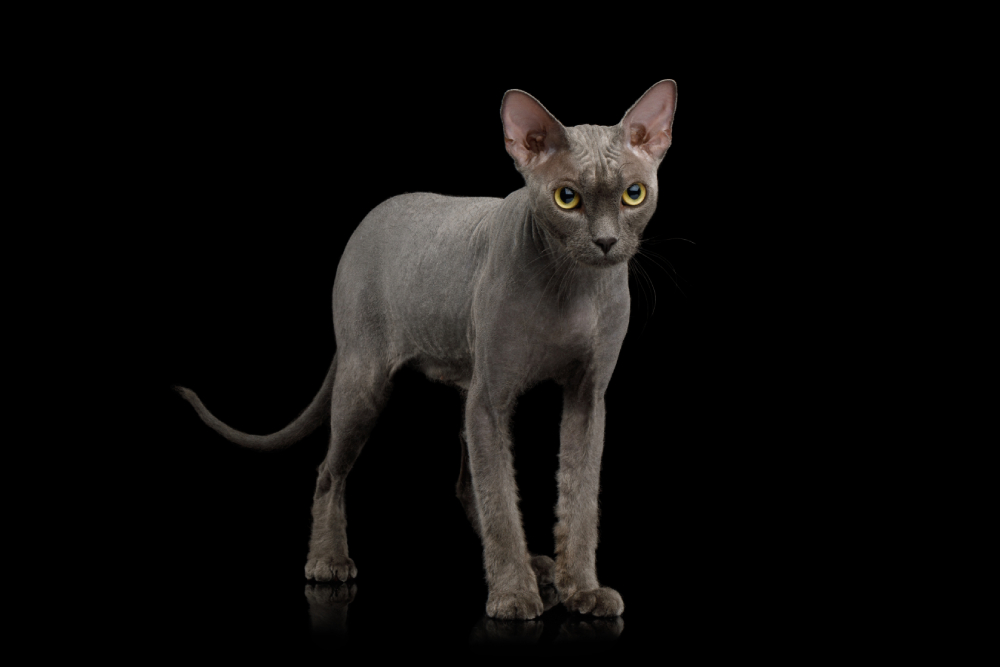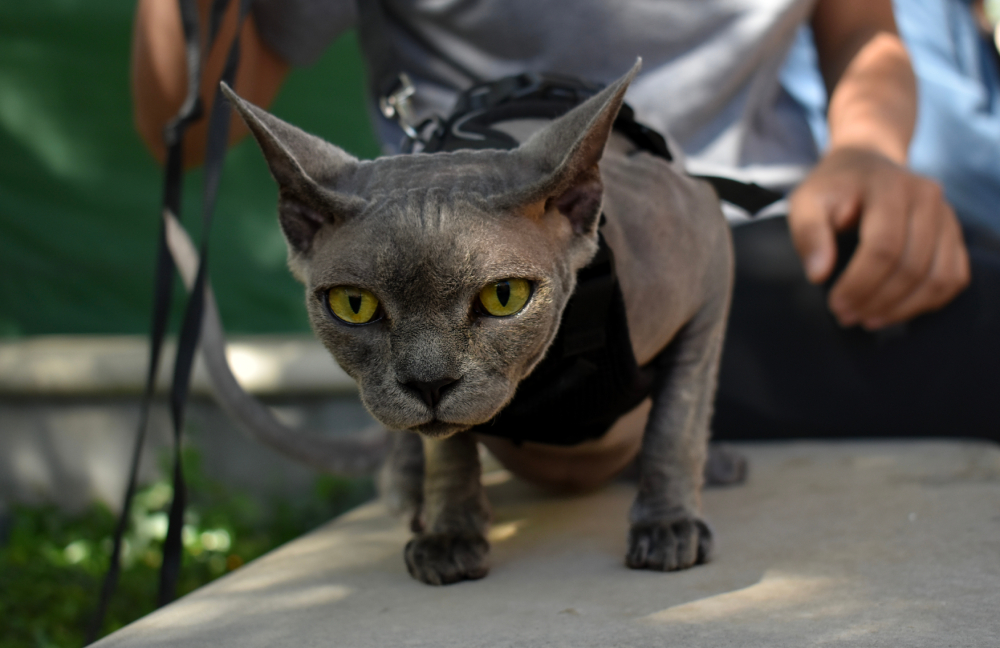- June 20, 2024
Grey Sphynx Cat: Pictures, Care, Traits & Info

Everything about the grey Sphynx cat screams for attention, starting with the animal’s hairless appearance. Relatively big ears and eyes also complete the look for this vocal feline. However, they aren’t hairless as their looks may suggest. Some refer to their fine down as “chamois leather” because of its texture and feel. While the breed standard recognizes all patterns and colors, grey is somewhat rare.
Breed Overview
Colors:
Grey, black, white, blue, cream, brown
Suitable for:
Active families looking for a people-oriented cat
Temperament:
Intelligent, affectionate, energetic, sweet
There’s much to love about the grey Sphynx. They love being around people and freely show their affection. It’s easy to see why the breed is the 10th most popular, according to the Cat Fanciers’ Association (CFA). The animal’s looks and personality are a winning combination with pet owners. This feline will make their presence known to everyone in or visiting the household.
Grey Sphynx Cat Characteristics
Energy
+
A high-energy cat needs a lot of physical and mental stimulation to keep healthy and happy, while a low-energy cat needs minimal physical activity, but still needs mental stimulation. When choosing a cat, It’s important to ensure their energy levels match your lifestyle.
Trainability
+
Cats that are easy-to-train are more willing and skilled at quickly learning prompts and actions with minimal training. Harder-to-train cats are usually more stubborn or aloof and require a bit more patience and practice.
Health
+
Certain cat breeds are more prone to various genetic health problems, and some more than others. This doesn’t mean that every cat in those breeds will have these issues, but they do have an increased risk, so it’s important to understand and prepare for any additional needs they may require.
Lifespan
+
Due to their size or potential genetic health issues of a specific breed, some cats have shorter lifespans than others. Proper nutrition, exercise, mental stimulation, and hygiene also play an important role in your cat’s lifespan and quality of life.
Sociability
+
Some cat breeds are more social than others, both towards humans and other cats and animals. Cats that are more social have a tendency to rub up on strangers for scratches or jump on laps for cuddles, while cats that are less social shy away, hide, are more cautious, and even potentially aggressive. No matter the breed or gender, it’s important to socialize your cat and expose them to many different situations.
The Earliest Records of the Grey Sphynx Cat in History
All hairless breeds didn’t begin or end with the grey Sphynx. Other unrelated cats exist, including Russia’s Don Sphynx. There are also other anecdotal accounts of earlier examples. The grey Sphynx’s story begins in Ontario, Canada, with a genetic mutation resulting in a hairless cat named Prune. It set the stage to breed cats with this trait.
This quest involved enthusiasts from Toronto and Minnesota. As word of this hairless feline spread, other breeders got involved, making it the goal of European and North American enthusiasts. Genetics added to the challenge. Hairlessness is a recessive trait. Each parent must contribute a copy or allele for it to present visually. If one parent doesn’t have it, the offspring have hair.
Infertility was another complication in developing the breed. Early mortality is another issue. A UK study found that the Sphynx had the shortest life expectancy of any cats tested.1 The dedication of the early enthusiasts was critical for the breed’s survival and subsequent popularity among pet owners. Breeders used Devon Rex cats as part of the breeding programs, making the two related.
How the Grey Sphynx Cat Gained Popularity
Cats have two main jobs: mouser and companion. The grey Sphynx undoubtedly has instincts of the former. However, the breed’s development also encouraged traits to complement the latter. The result is an ongoing animal with high intelligence and curiosity. Instead of running when someone knocks at the door, this kitty rushes to see who is visiting their home.
The Sphynx’s personality helped propel the kitty’s popularity. They are the antithesis of the aloof cat. This pet is quite people-oriented, which selective breeding encouraged. The breed has earned its place in the hearts of cat owners worldwide.

Formal Recognition of the Grey Sphynx Cat
Official cat registries put the welfare of the animal above all else. That rests with the genetic diversity and viability. A small gene pool means a greater risk of undesirable traits or hereditary and congenital conditions passing on to the kittens. Developing the breed meant bringing new animals with the hairless trait into the mix. It also relied on the persistence of enthusiasts to continue their efforts.
Their efforts paid off, with formal recognition by the Cat Fanciers’ Association (CFA) and Fédération Internationale Féline (FIFe) in 2002. The International Cat Association (TICA) recognition soon followed in 2005. Each organization created breed standards, which further added development. Of course, seeing the grey Sphynx in the show ring earns more recognition and fans.
Top 3 Unique Facts About the Grey Sphynx Cat
1. Research Has Shown that the Sphynx Is One of the Least Fearful Cats
Some personality traits are heritable, and the grey Sphynx is living proof as one of the least fearful felines.
2. Scientists Have Found the Sphynx Has a Greater Risk of Cardiovascular Disease
Selective breeding sometimes comes with a price. For the Sphynx, there is a greater risk of hypertrophic cardiomyopathy (HCM) and mitral valve dysplasia (MVD).

3. The Grey Sphynx Isn’t Hypoallergenic
Just because the cat doesn’t have hair doesn’t mean they are hypoallergenic. That’s true with the gray Sphynx and other felines. The offending allergen exists in the animal’s saliva, making it impossible to avoid.
Does the Grey Sphynx Cat Make a Good Pet?
The grey Sphynx is a sweetheart. These cats are affectionate, inquisitive, and intelligent, making them different from many feline breeds. They aren’t the independent cats many may think of these animals. They can entertain themselves, but they also thrive on human interaction. Note that separation anxiety is a concern for pets left alone a lot, so we don’t recommend this cat for individuals who aren’t home much.
All pets are a commitment, and this breed has some health issues that require monitoring. We recommend getting cats from reputable sellers who conduct pre-breeding screenings. DNA testing can identify some potential problems. You should also stick with breeders who offer a health guarantee to protect both you and the cat. Regular veterinary is imperative because of these heritable issues.
You may find it challenging to find a grey Sphynx because of their relative rarity. However, your search isn’t for naught. They are lovable animals worth the effort. Understanding your commitment as a pet owner is essential. These cats can become true family members, especially if they have things their way.
Conclusion
The grey Sphynx is a fascinating animal and the undying product of the dedication of enthusiasts. The breed has its issues, but they are nothing an engaged pet owner can’t handle. They have the energy and curiosity to make having one in your home one of the best decisions you’ll ever make. Just make sure you can keep up with the cat’s activity level and chattiness!
Featured Image Credit: Seregraff, Shutterstock
Tags
What do you think?
Related Articles

New Puppy Checklist: Gear You’ll Need for Your New Dog
Getting a new puppy is really exciting, but before you welcome them home, it’s important to prepare your space for them. Since puppies need a

How Big Do Mini Poodles Get? Vet Reviewed Average Weight & Growth Chart – Dogster
The information is current and up-to-date in accordance with the latest veterinarian research. Learn more » When you buy a Miniature Poodle, you might not

Can Police Dogs Smell Nicotine? Vet Verified Facts & Info – Dogster
The information is current and up-to-date in accordance with the latest veterinarian research. Learn more » While cigarette sales have been declining steadily for decades,

How Old Is 5 in Dog Years? Vet-Approved Guide to Each Size of Dog – Dogster
The information is current and up-to-date in accordance with the latest veterinarian research. Learn more » A common method for calculating a dog’s age is




